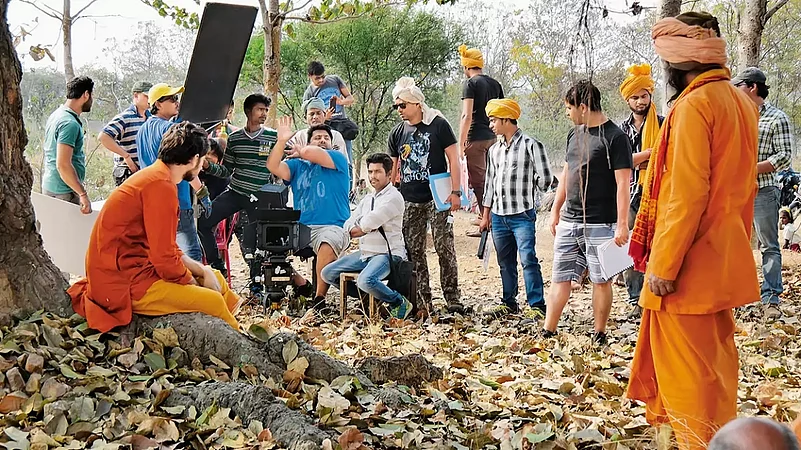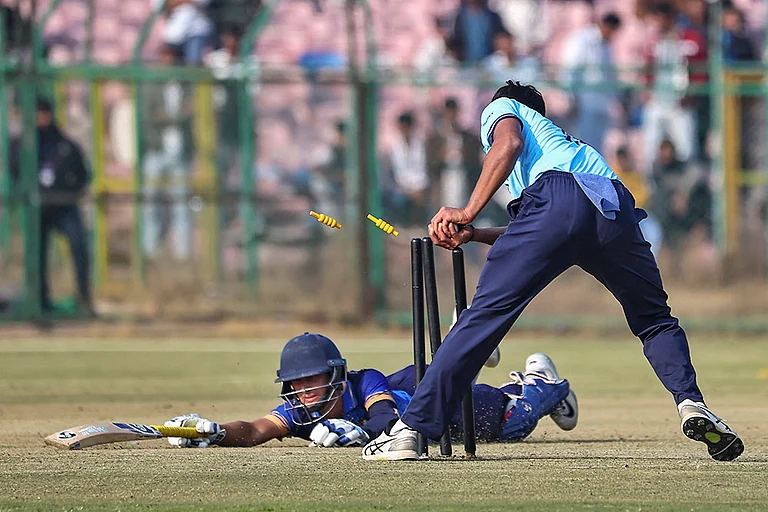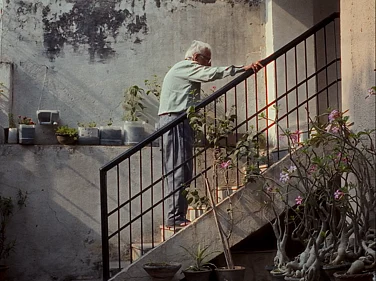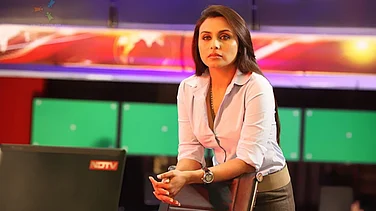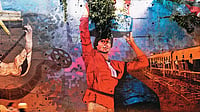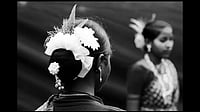A 22-year-old woman who doesn’t fit into the traditional standards of beauty and appearance to make it big in the Hindi film industry; a young man in his 20s putting up a facade in front of his family to hide his struggles in Bombay; a middle-aged Lavani dancer who has received international accolades for her art but is looked down upon by her own family; a 70-year-old man who had to mortgage his wedding ring because despite being in the industry for 50 years, he still doesn’t have enough money. Innumerous struggles, but one Bollywood Dream. These are some of the stories documentary filmmaker Gautam Singh brings out to the world in Al Jazeera’s recent show, Bollywood Dreams. Singh speaks to Outlook’s Daniya Rahman about the making of his show, the ugly side of the Hindi film industry, and the aspirants who despite everything, strive to be a part of it.
How did Bollywood Dreams happen? What made you decide that you need to capture and share these stories?
I grew up in a remote village completely cut off from the rest of the world. I practised the barter system as a kid. But my father ensured that I moved out at a young age. After completing my education at a film school in Jamshedpur, my home town, I came to Bombay and became a film editor. My professional journey started with Bollywood before moving to Al Jazeera in 2007 as a documentary filmmaker. Since then I have been travelling and making documentary films for them. But I kept thinking about how after I moved out and money started coming into the village, the nature, culture, and entire way of life changed.
Even though I had moved out and become an outsider, I wanted to tell the story of my village and that’s how Gaon happened. While shooting Gaon, I worked closely with people from behind the scenes. I spent hours and hours with them, visited slum houses, stayed there and got a taste of their lives. It struck me at that moment, that more than my story, it's their struggles and stories that need to be heard.
I felt the immediate need to narrate their stories. I started working on it in 2018 and would have finished by 2020, but it got delayed because of COVID. This year, finally, Bollywood Dreams was completed and put out in the world for others to see.
How did you choose the seven whose stories we see in Bollywood Dreams? Many people are going through similar struggles, so the choice must have been difficult.
I wanted to narrate the stories of people beyond the handful who are known worldwide from Bollywood. I also had a limitation of doing four thirty-minute films while making them entertaining enough to be consumed by the audience. So, priority was given to actors – they struggle the most in the industry, and most of the people who come to Bollywood wish to become successful actors one day.
I wanted to do a story on female actors and found out about a woman from Nepal who came to India to become an actor – Nirisha, from the episode Daydreams of Stardom and Nightmares of Failure. In the same episode, there’s the story of a stuntman. Bollywood provides no insurance to stuntmen who risk their lives performing stunts on sets with barely enough safety provisions. The story of Vidya Shetty lays bare this ugly side of the unorganised industry that is Bollywood. Eighty per cent of the people on the set do not even work under contracts. They are daily wage earners, and in case of any mishap, nobody takes any responsibility.
The next thing I wanted to capture was the story of two generations of actors. The story of Sunny and Prashant in the episode Recurring Dreams: Bollywood’s lifelong fight for fame is about that. I originally wanted to do that story with strugglers from the Bollywood hostel in Mahim, but it shut down during COVID so I chose two individual characters, 70-year-old Sunny, in contrast to Prashant, a young man in his 20s. Despite the age gap, they both share the same dreams and believe that they will make it big in the industry. But in Prashant’s journey, we see Sunny’s past and in Sunny’s journey, we see Prashant’s possible future.
The episode Dare to Dream: The Bollywood dancers is about Vijaya, a Lavani dancer, and Satish, a young choreographer struggling for recognition in Bollywood’s competitive dance industry.
The first episode, The Little Woman With Big Dreams, which is the story of Rajni, happened by chance. I met her because she was part of the theatre group Prashant was part of. She was going to her village in Haryana at the time. I accompanied her and started filming, and layer by layer her story unfolded itself. She had to get married to her brother-in-law just because she didn't have the features or the height to be a “suitable” bride. But eventually, she becomes the only breadwinner of her family. Her story is a reflection of the multi-layered culture and society of India.
In Rajni’s episode, the theatre director Vivek says, “to me, physical appearance doesn’t matter, I chose her because she is talented”, and the very next shot shows Rajni talking about her hardships in Bollywood due to the same reasons.
Exactly, Vivek is a rare example, a small hope in this industry. He follows his principles. People like him do not earn money, they have their struggles. People like Rajni cannot survive in Bollywood without people like Vivek.
Is it also because of the difference between theatre and films?
The difference shouldn’t exist, both are mediums of expression. But unfortunately, Bollywood has turned into a factory looking for materials just like you would for constructing a house. Bollywood doesn't care for creativity, it looks for masala – dance numbers, beautiful faces to lead, and so on for constructing the product.
Unlike Bollywood, regional cinema is writing for a cause, for a real character and that's when you need characters like Rajni. If people can connect with Rajni’s big dreams, why can't a character like Rajni be written for cinema?
We need to turn the wheel and make our films less commercial. We live in a charade that this is an industry and we need to survive commercially. No art is produced for a specific audience. When a painter paints, they don't have an audience in mind. Every art form is a creation which reflects the ego of the artist. If the audience likes it, well and good and if they don't, it should not matter.
Dibakar Banerjee’s Khosla ka Ghosla (2006) is a good example. It was made on a very small budget. There were no buyers for two years, the producer backed out and Dibakar Banerjee had to put in his own money. The producers wanted to add fight sequences and dance numbers. They also wanted to change some of the faces. But it was one of Dibakar’s first films and he was quite convinced about it. It was shot on 16mm and would be shown on half screen. And when UTV released the film, it did quite well. That's how it should be. Casting big stars doesn’t guarantee anything anyway, so the focus should be on making good films.
And the audience is evolving. The biggest problem for Bollywood is that we believe the audience is dumb. So coming back, I do believe there is hope for these artists, nobody can do cinema of real people better than the people who are coming from that reality.
But we’re treading into a dangerous path in the industry right now. So far, the “masala” in films used to be dance numbers, action sequences or a star face, but now, with the success of films like Kashmir Files and Brahmastra, the new masala they have found, is the extreme Hindu symbolism. This is truly dangerous and can kill the art form.
In the Lavani dancer Vijaya’s story, we see that while she is being recognised for her art and is doing quite well, her family rejects her and compares her dance form to prostitution. Despite everything, Vijaya carries on and finds someone who supports her on her journey. But Rajni is not lucky enough and is struggling to carry on. There’s also Nirisha and Satya from Chasing Bollywood Dreams who face sexual harassment. Tell us about your experience talking to these women, recording their lives and hardships and eventually sharing it with the world.
It is not just Bollywood but our entire society that is filled with lecherous men. Thankfully women have started talking and raising their voices. Satya and Nirisha, have spoken so clearly about these problems, including the kind of messages they receive. I have seen it on sets as well. The problem is in the mindset.
No matter how successful or powerful a girl gets, she is always threatened. We are such a hypocritical society, we theorise and idolise women in grand images but when it comes to practising such ideals, very few men do it. This change has to come from our own homes. The stories of women like Satya, Rajni, Nirisha, and Vijaya reflect the sad reality of our world where it's all about power.
When I went to Vijaya’s home in Satara village, her mother, another woman, was more resentful. She felt cheated that Vijaya went against her wishes. The world recognises Vijaya’s talent but at home, she is treated as a bad child. Not only by her father but also by her mother. The same goes for Satya, who was also cut off from her family.
This is the problem of our society, of our psyche, that if you are a girl child you have to obey. As a woman, you have to take care of the children and family. The only respectable career options are to become a teacher or join a bank. If you choose a career that demands you stay out at night, how will you fulfil these responsibilities? This is the regressive thinking that people like you and me have to constantly work against if we want to bring any change.
What are your thoughts on the Hindi film industry as we know it today?
The stories in Bollywood Dreams reflect the real struggle of people and the sacrifices they make for their dreams. Prashant drives an auto rickshaw. Sunny had to mortgage his wedding ring even after giving fifty years of his life to the film industry. They don't even earn enough to survive, but for them, it is either this Bollywood dream or nothing. On the contrary, third or fourth-generation film stars get this opportunity on a platter. They can keep failing but they would still get work and the producers would choose them because they bring publicity to films. But that is not how art is produced.
I'll tell you a story that we were told in film school. When Rajesh Khanna was at the peak of his career, he wanted to do a film with Hrishikesh Mukherjee, who was aware of Khanna’s habits of coming late to shoots and leaving early. He didn't want to do a film with him but Khanna insisted. When he met Hrishikesh Mukherjee, he asked him, “When was the last time you saw a sunset?” He couldn't remember so Mukherjee told him to take a break, go around, live a common man’s life, see a few sunsets and then come back to do a film. That's how Anand was made.
This spirit is what’s lacking in our industry right now. Nobody does what is required, they just look at a script and try to mimic it. There is no connection with nature, no poetry and you can feel it as you watch the film. That is the biggest problem. There are a lot of good filmmakers, and a lot of good writers as well but the industry has turned into a factory.
Earlier, writers would spend a year on their script before approaching a producer or a production house. Now the procedure has completely changed, every production house has a team of writers. So you approach the production house as a director or filmmaker with just an idea. Once it is approved, this team of writers write the script for you. Their writing process is really strange.
Independent writers pitch their script to a production house, they show interest in the synopsis and ask for the full script. About a month or so after sending the script, writers often get a reply in the same template saying the production house is currently not making a film on the said subject or idea. But what these production houses do is add these scripts to a repository of different profiles – village, city, communal, love story, action film profile etc. And when a director or producer comes up with an idea to do a film, this committee of scriptwriters pulls out one of these profiles and chooses characters from several such scripts. The film is then produced out of the scripts of these various independent writers.
This is why nothing new or original is coming out – we are killing our creators. It happened to me as well with Gaon. Before I decided to do the film by myself, I had pitched it to some well-known producers. Soon after Gaon was released, a film trailer was also released by one of the biggest production houses in the industry. A few people who had watched the trailer shared it with me saying it looked like Gaon. The production house had not even bothered to change the dialogues. The film was supposed to release that week. So I wrote to the production house and they immediately pulled out the trailer. Two years later, the film has yet not seen the light of day. But this is just one case, there are plenty I know who go through the same problem.
Nepotism is everywhere, but it is not just nepotism, they are stealing scripts. The big production houses of Bollywood do things in such a filthy way that the original creator can't even claim that it was their idea or character.
Can you talk about any other characters you wished to capture for the series if there had been scope for it?
Well, the characters I had decided to shoot at first versus the ones I ended up shooting were completely different. I had chosen those characters in 2018 while I was shooting Gaon but then almost all of them moved on. Some people left Bollywood and moved back to their villages. I will give you an example, the girl Nirisha was not a character in my film till the last moment. Instead, the character I was to shoot was Yaaneea Bhardwaj from Himachal Pradesh. She got into modelling at an early age to fulfil her family’s financial needs and then moved to acting. But as I was about to begin shooting, she met with an accident and was bedridden for months. I would have loved to work with her because it was an important story, but I couldn’t.
For stuntmen, I wanted to shoot with someone who was doing stunts, but I didn't get permission to shoot at their location from any producers. So that didn't happen either.
There must have been the fear that you’d capture and expose reality.
Indeed.
What are your thoughts on anonymous aspirants in the Hindi Cinema industry?
It is heartbreaking. They ran from their homes, to get away from that anonymity. They wanted to make a name for themselves. But they remain anonymous. They try their best to make it big in Bollywood, but that doesn’t happen. We need to stop and think about making the cinema industry better. It is an art industry which is going further and further away from reality. What sort of art are we making if it does not represent reality? I think we need to go back and bring real-life films, real love stories, real stories of friends, families, brothers and so on. Stories that demand real people, and then these people will shine.
(This appeared in the print edition as "The Substance of Dreams")






